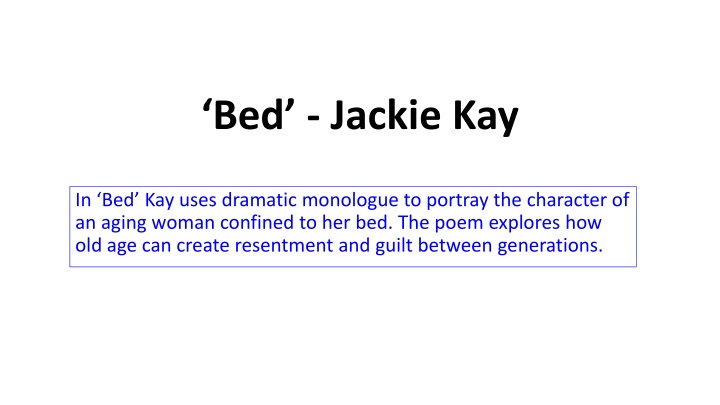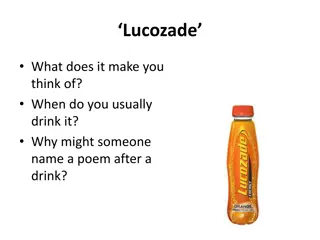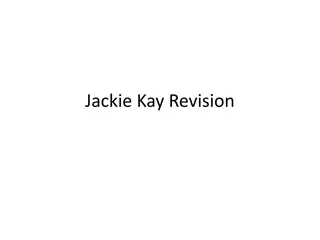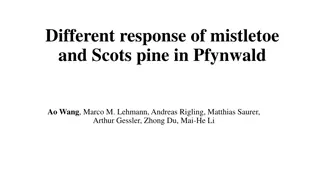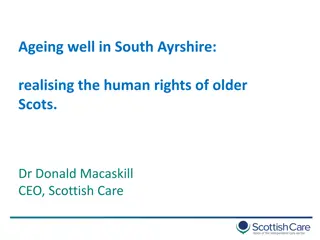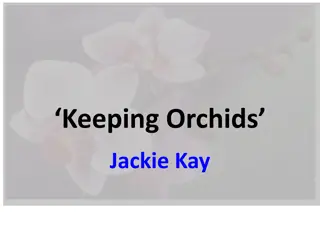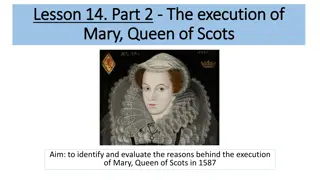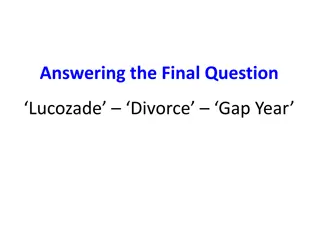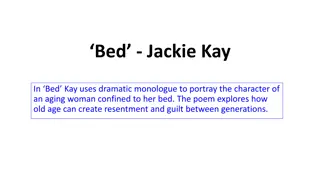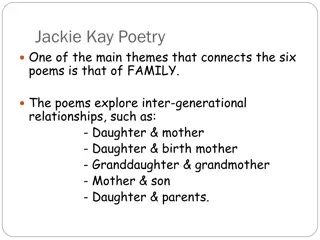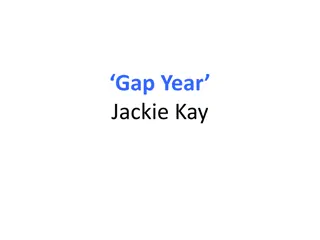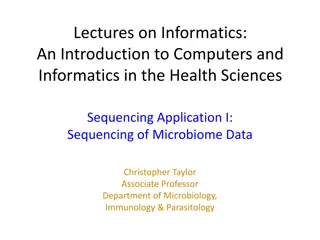Analysis of "Bed" by Jackie Kay: Themes, Form, and Use of Scots
"Bed" by Jackie Kay is a dramatic monologue portraying the perspective of an elderly woman confined to her bed, exploring themes of aging, resentment, and guilt between generations. The poem uses Scots to add immediacy to the narrative, highlighting the woman's reliance on her daughter and contemplation of time and mortality. The tight structure of ten quatrains reflects the woman's constrained life, while the use of dramatic monologue provides insight into her character and societal commentary on old age. The colloquial Scots language enhances the vividness of the speaker's voice, creating a realistic and engaging portrayal.
Download Presentation

Please find below an Image/Link to download the presentation.
The content on the website is provided AS IS for your information and personal use only. It may not be sold, licensed, or shared on other websites without obtaining consent from the author.If you encounter any issues during the download, it is possible that the publisher has removed the file from their server.
You are allowed to download the files provided on this website for personal or commercial use, subject to the condition that they are used lawfully. All files are the property of their respective owners.
The content on the website is provided AS IS for your information and personal use only. It may not be sold, licensed, or shared on other websites without obtaining consent from the author.
E N D
Presentation Transcript
Bed - Jackie Kay In Bed Kay uses dramatic monologue to portray the character of an aging woman confined to her bed. The poem explores how old age can create resentment and guilt between generations.
'Bed' is written from the perspective of an elderly invalid who is confined to her bed. The poem uses Scots to add immediacy and expression to her narrative. The elderly woman relies on her daughter to look after her. She describes her current situation and contrasts it with her past. This gives us an understanding of her relationship with her daughter. The last two stanzas are more reflective in tone as the woman contemplates time and how much of it she has left. She considers the effect her death might have on her daughter. She hopes her daughter will feel guilty that she didn t try harder to mend their relationship.
Form and structure This poem has ten four line stanzas or quatrains which creates a tight structure. This could reflect the constrictive life the woman leads confined in bed. There is a shift in tone in the last two stanzas where the character moves from her observations to becoming more philosophical about time passing and her own imminent death. Dramatic monologue Kay uses the monologue form to enable the reader to gain a greater understanding of the elderly woman s character and her reaction to her situation. Speaking in the present tense, she is very open and honest with the reader, sharing her personal concerns and feelings about being confined to bed. Her story provides a commentary on what it is to be old in our society and the humiliation and helplessness one feels when forced to be dependent on the next generation.
The use of Scots The monologue form creates the impression that the character is speaking directly to us. This is made more vivid by the use of Scots, which makes the tone more colloquial and expressive. She uses words such as wean , tattie , blethers and crabbit . This gives us an impression of a realistic character. It is as if we are sitting beside her bed, listening to her relate her story.
Bed She is that guid tae me so she is an Am a burden tae her, I know Am ur. Stuck here in this big blastit bed year in, year oot, ony saint wuid complain. There s things she has tae dae fir me A wish she didnae huv tae dae. Am her wean noo, wey ma great tent o nappy, an champed egg in a cup, an mashed tattie.
Aw the treats A used tae gie her, she s gieing me. A dinny ken whit happened. We dinny talk any mair. Whether it s jist the blethers ha been plucked oot o us an Am here like some skinny chicken, ma skin aw bubbles and dots and spots, loose flap noo (an yet as a young wuman A took pride in ma guid smooth skin.)
Aw A dae is sit and look oot this windae. A ve seen hale generations graw up an simmer doon fray this same windae that s no seen a lick o paint fir donkeys. The Kerrs have disappeared, but the last Campbells ur still here so Am telt tho hauf the time A dinny believe her: A ve no seen any Campbell in a lang time.
My dochter says Awright mother? haunds me a thin broth or puried neep an A say Aye fine, an canny help the great heaving sigh that comes oot my auld loose lips, nor ma crabbit tut, nor ma froon when A pu ma cardie tight aroon ma shooders fir the night drawin in. Am jist biding time so am ur.
Time is whit A hauld between the soft bits o ma thumbs, the skeleton underneath ma night goon; aw the while the glaring selfish moon lights up this drab wee prison. A ll be gone and how wull she feel? No that Am saying A want her guilty. No that Am saying Am no grateful.
Quote Hunt Work in groups to find the words and phrases from the poem which are referred to on the sheet which you have been given. Write the quotes on your sheet.
A word that shows the speaker feels like an inconvenience to her daughter burden An expression that shows the speaker is angry about her situation Stuck here in this big blastit bed Three words or phrases that show the speaker feels she is being treated like a child Am her wean noo wey ma great tent o nappy Aw the treats A used tae gie her, / she s gieing me. Three words or phrases that suggest the speaker feels ugly Am here like some skinny chicken ma skin aw bubbles and dots and spots loose flap noo
The four foodstuffs mentioned in the poem champed egg in a cup thin broth mashed tattie puried neep A word that tells us things have changed suddenly plucked ? An expression or word that tells us the mother and daughter don t communicate anymore We dinny talk any mair. Something mentioned that is aging and uncared for, besides the speaker this same windae that s no seen a lick o paint fir donkeys.
An expression that suggests she isnt certain her daughter tells her the truth so Am telt tho hauf the time A dinny believe her Two expressions that suggest the mother and daughter find it difficult to talk about anything important My dochter says Awright mother? an A say Aye fine, an canny help An expression that suggests her unhappiness the great heaving sigh that comes oot my auld loose lips, nor ma crabbit tut, nor ma froon An expression that tells us she feels cold A pu ma cardie tight aroon ma shooders fir the night drawin in.
A word or expression that suggests death Am jist biding time so am ur. the skeleton underneath ma night goon A word that suggests she feels trapped by the room that she is in (drab wee) prison A word or expression that suggests she is frail the skeleton underneath ma night goon Four words that are repeated at the start of the last two lines No that Am saying
Now you are going to colour code the annotations on your copy of the poem.
The Bed of the title is the main focus of the characters life. In a sense it is the main problem in her life - if she was not stuck in bed, she would be free of the dependency she is so tired of. Bed Alliteration plosive b , combined with the expletive, suggests her frustration at being trapped by her circumstances. The woman begins by speaking about her daughter. The use of idiomatic language - patterns and inflections of real speech - establishes the confiding voice that pervades the whole poem. She is that guid tae me so she is an Am a burden tae her, I know Am ur. Stuck here in this big blastit bed year in, year oot, ony saint wuid complain. Repetition - also confirms the similarity in her routine that is ultimately wearing for her and her daughter. Word choice suggests a sense of her martyrdom.
Stanza two conveys the woman s humiliation. She wishes she was not so reliant on her daughter. The humiliations/indignities of being cared for are conspicuous. She is very aware of her situation. Her body is weakened, but her mind is not. Role reversal - the metaphor suggests the size of the nappy. By exaggerating its size, she suggests the ridiculousness of the woman s situation. Her situation is embarrassing for her. There s things she has tae dae fir me 5 A wish she didnae huv tae dae. Am her wean noo, wey ma great tent o nappy, an champed egg in a cup, an mashed tattie. Her food is bland, unexciting, and mundane. Not only does she have to wear a nappy like a child, but she must also eat easy to chew baby food. This is the food of invalids - uninspiring and lacking in enjoyment. In this way it can be seen to represent the woman s life.
We learn in this stanza that there is tension, a breakdown in communication and a loss of intimacy between the two women. Word choice blethers small talk. Is the daughter resentful having to look after her mother, seeing her as a burden? Is the elderly woman struggling to come to terms with this? Stanza three begins with the mother thinking back to when she looked after her daughter, continuing the idea of role reversal. The use of enjambment emphasises the change in roles, taking a new line for the daughter s new role as carer. The persona has lost control / agency and is bewildered at this change. Aw the treats A used tae gie her, she s gieing me. A dinny ken whit happened. 10 We dinny talk any mair. Whether it s jist the blethers ha been plucked oot o us. Word choice plucked - connection to feathers and the violence of the removal of communication, suggesting it is gone forever and is irretrievable. We can infer that their relationship was better in the past - they used to blether and perhaps confide in each other, but now they have lost their intimacy.
Simile -the bird image is extended, conveying the mothers very negative feelings about how she has aged and how this is reflected physically. This shows her vulnerability she feels ugly, unnatural, as if she is being prepared for the end. List suggests illness / disease. an Am here like some skinny chicken, ma skin aw bubbles and dots and spots, loose flap noo (an yet as a young wuman 15 A took pride in ma guid smooth skin.) She remembers a time when she had guid smooth skin . The implication here is that old age brings ugliness and disrepair, whereas youth is guid and something to be proud of, in contrast with the indignity she is now experiencing. This gives us a clear insight into how the woman sees herself and how she is negatively affected by old age and is also a comment on the way society sees old age as bad and youth as guid .
We learn that the woman is near the window. Aw this is everything to her, the only thing she has. This allows her to look out on hale generations growing up before her; she is passive, trapped behind the window, she can see but not communicate. It is implied that she stands outside the family unit because of her age and frailty. Kay suggests that this is what it is to be old: sitting on the sidelines, observing life take place before you. Aw A dae is sit and look oot this windae. This suggests youth is impetuous / vibrant; as you age, you go off the boil. This contrasts with same windae which suggests the monotony and sameness/predicta bility of her life. A ve seen hale generations graw up an simmer doon fray this same windae that s no seen a lick o paint fir donkeys. 20 Length of time is suggested again. Symbolism the window frame is also aging and uncared for and lacking attention. This reflects the woman s neglected and saddened state.
Whole generations/families are moving on. Enjambment focuses us on last, meaning they are the end of the family line. so Am telt - she is unable to participate in the world around her so is passively relying on her daughter to give her second hand information. The Kerrs have disappeared, but the last This shows her limited view/perspective and reinforces that she is looking for remnants of the past, things she recognises. Campbells ur still here so Am telt tho hauf the time A dinny believe her: A ve no seen any Campbell in a lang time. She feels as though she is being misled and that her daughter is not being truthful. Is the daughter trying to protect her mother from news that might upset her? Or does she just not have the energy to explain the changes in the outside world to her mother?
The lack of genuine communication between mother and daughter is highlighted in their dialogue. It is clear the mother is not fine and the daughter in not that concerned about her welfare it is as if she is on autopilot. The daughter s question has no real meaning and is darkly ironic she is not seeking a genuine answer as the answer is clear. The mother s reply is equally meaningless. My dochter says Awright mother? 25 The broth is weak and insubstantial and the turnip is like baby food again, suggesting a lack of investment / care in its preparation. haunds me a thin broth or puried neep an A say Aye fine, an canny help the great heaving sigh that comes oot Enjambment - the elderly woman's heaving sigh in response to her mundane sustenance spills into the next stanza. This highlights the length of the sigh and the extent of the sorrow it reflects. Long vowels suggest the sigh/her despair and hopelessness.
The action of pulling her cardie tight around her as the night draws in tells us how she tries to protect herself from the cold nights in her solitary bed. The night also suggests the oncoming darkness of age. The shortness of vowels and the jagged consonants suggest her disapproval and irritation. my auld loose lips, nor ma crabbit tut, nor ma froon when A pu ma cardie tight 30 aroon ma shooders fir the night drawin in. Am jist biding time so am ur. It is also suggested that she is aware she is facing the inevitable and is simply biding time in the last stage of her life and is waiting to die. It suggests her fear and vulnerability. Enjambment - the elderly woman's heaving sigh in response to her mundane sustenance spills into the next stanza. This highlights the length of the sigh and the extent of the sorrow it reflects. Long vowels suggest the sigh/her despair and hopelessness.
The language and tone change in the final two stanzas as the speaker becomes more reflective and philosopical. Metaphor - the woman imagines time to be tangible, something she can hold between her thumbs. She has a tenuous grip on it, there is not much left, it is gossamer thin and will soon wear away. Time is whit A hauld between She refers to the skeleton underneath her gown, highlighting her weak state the effect the ravages of time have had on her. Her flesh has gone; what s left is simply bones. Death is waiting for her. Only a glaring selfish moon enters her room at night. This moon is not giving; the personification makes us think of her daughter and those around her. the soft bits o ma thumbs, the skeleton underneath ma night goon; 35 aw the while the glaring selfish moon This could be seen to continue the chicken image - first her feathers have been plucked out, in time her flesh too will be picked off, leaving only bone. It suggests the passing of time literally she has been there all day and has connotations of death.
Despite the fact it provides light, the moon only illuminates a drab wee prison , reminding the speaker of her confinement and the inevitability of her fate. Her bed and her body are like a prison, though her mind is still obviously active. lights up suggests it brings a small amount of cheer / joy / relief. The final lines return to the daughter and the main relationship portrayed in the poem. The rhetorical question confirms the speaker s disillusionment at being stuck in bed all day. She challenges her daughter not to cope after she is gone. lights up this drab wee prison. The repetition of No in the last two lines implies she does want her daughter to feel guilty and sheisn t grateful for the tasteless meals and neglect. A ll be gone and how wull she feel? No that Am saying A want her guilty. 40 No that Am saying Am no grateful. However, perhaps it is not so much the daughter who upsets the speaker but the fact that she is immobile and trapped in a situation that she has no way of improving. The real target for her frustration is old age - it is this that causes her to be confined in bed all day, reliant on others for her existence.
Overview notes Written in 10 quatrains and in a Scots dialect. Offers a Talking Heads type voice to the reader. The speaker is someone we sympathise with but we can also detect what seems to be her bitterness and anger. The speaker is marginalised demonstrated clearly in her position at the window. She has no direct access to the world outside; the window is an invisible barrier. She is both aged and invalided, a double marginalisation. Ideas about communication. She can communicate her feelings quite clearly the poem evidences this. But with the daughter, there is only the pretence of communication.
Overview notes Although a very narrowly focused domestic piece even the title firmly positions it not just in the home but in a bed it is vast in its scope, and offers and almost Shakespearean lament on the destruction of beauty by time. Shift in tone between stanza 7 and 8: - Before, we read about the negatives, the difficulties, the fragilities of such a life. - After seems more about wisdom and insight; an idea that this is the point of clearest understanding of her predicament and future.
Themes Kay explores the debilitating effects of old age and its negative impact on the whole family. Through the predicament of the bedridden speaker, Kay examines how the elderly can become wholly dependent on the next generation. Old age The woman feels helpless and humiliated, blaming her daughter for the mediocrity of her daily routine as well as her isolation. It is clear that her daughter does look after her but does not involve her mother in the family s life. We are only presented with the older woman s perspective, as she views the situation from the prison of old age. Overall the impression is that old age causes the colour and life to ebb from you, leaving you waiting for the inevitable, unable to help feeling hard done by.
Themes The relationship between an ageing mother and her daughter is explored in this poem. It shows how old age and ill health have led to each woman resenting the other. It is implied that their relationship was once a good one. Mother-daughter relationships The daughter provides her mother with food and a bed, but that appears to be the extent of her care. The bedridden mother is unable to fend for herself. This is perhaps a drain on the daughter. Years of living in these circumstances have proved trying for their relationship and left the mother ostracised from her family, stuck looking out the window. The final lines of the poem imply that the mother feels ungrateful and wants the daughter to feel guilty for neglecting her. However, we wonder if she truly means this, or whether it is the bitterness in her fate that is talking here.
Themes The theme of isolation is developed throughout this poem - Old age is portrayed as an isolating force. The old woman is removed from the rest of the family as she is confined to her big blastit bed . Isolation Her position next to the window implies that she looking on at other people s lives through a barrier. She is a spectator unable to take part herself. Even her neighbours have gone, leaving her to contemplate her final years alone. She and her daughter do not talk any more. The woman has to face each night with its selfish moon alone, with only her cardie to protect her from the cold of her prison .
Areas of comparison Bed has areas of commonality with several of the other poems in the group. My Grandmother s Houses The sound of the ambulances at the end of My Grandmother s Houses reminds us that this poem is about the final years of an aging relative, similar to Bed . However, this poem contrasts with Bed as the grandmother s stubborn energy and determination, not impeded by illness, prevents her from becoming dependent upon her family.
Areas of comparison Bed has areas of commonality with several of the other poems in the group. Lucozade 'Lucozade also can be compared to Bed . The central relationship is also between mother and daughter and the mother is confined to her hospital bed for a period of time. However, again we see a character who will not give in to the routine of illness, as she demands a bottle of brandy and a meringue. Unlike Bed , the daughter listens to her mother, but she is a lot younger and has not been worn down by constantly caring for her aged relative.
Areas of comparison Bed has areas of commonality with several of the other poems in the group. Gap Year Gap Year contrasts with Bed as it depicts a very warm and close parent- child relationship. In this poem, Kay is learning to give her son his independent and in turn be less dependent on him. Again this contrasts to Bed where the mother is solely reliant on the daughter.
